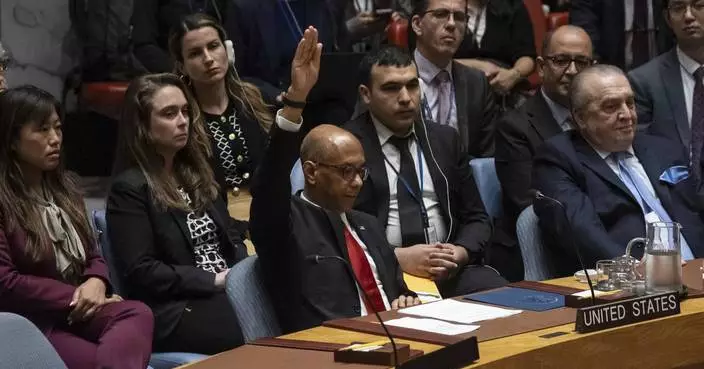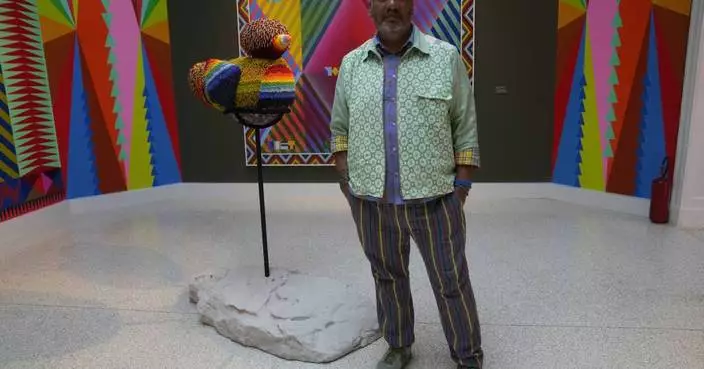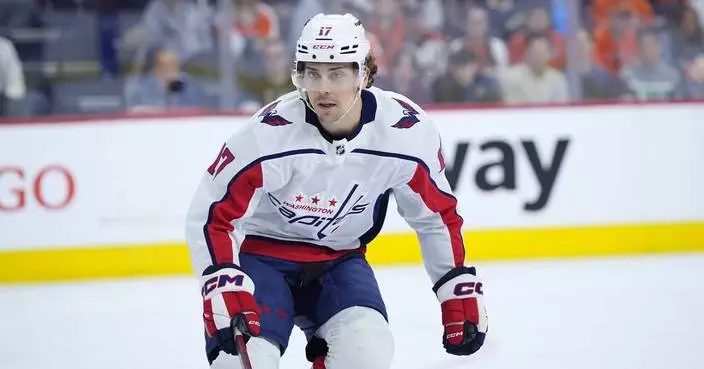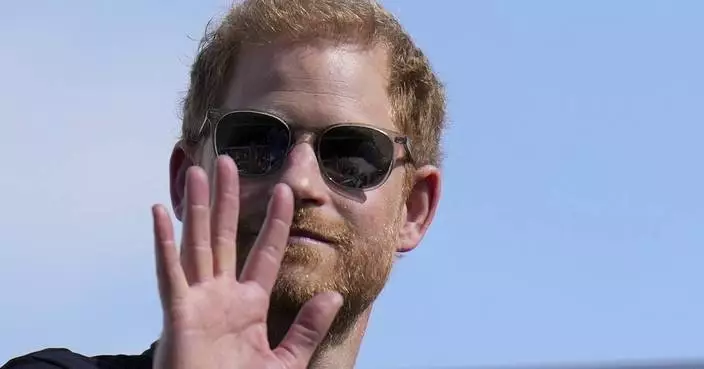American crocodiles, once headed toward extinction, are thriving at an unusual spot — the canals surrounding a South Florida nuclear plant.
Last week, 73 crocodile hatchlings were rescued by a team of specialists at Florida Power & Light's Turkey Point nuclear plant and dozens more are expected to emerge soon.
Click to Gallery
Wildlife biologistcrocodile specialist Michael Lloret, center, pilots an airboat as Bianca Soriano, left, Florida Power and Light (FPL) spokesperson, rides along, through a section of the cooling canals next to the Turkey Point Nuclear Generating Station, Friday, July 19, 2019, in Homestead, Fla. The 168-miles of man-made canals serve as the home to several hundred crocodiles, where a team of specialists working for FPL monitors and protects the American crocodiles. (AP PhotoWilfredo Lee)
American crocodiles, once headed toward extinction, are thriving at an unusual spot — the canals surrounding a South Florida nuclear plant.
From January to April, Michael Lloret, an FPL wildlife biologist and crocodile specialist, helps create nests and ponds on berms for crocodiles to nest. Once the hatchlings are reared and left by the mother, the team captures them. They are measured and tagged with microchips to observe their development. Lloret then relocates them to increase survival rates.
Temperature determines the crocodiles' sex: the hotter it is the more likely males are hatched. Lloret said this year's hatchlings are male-heavy due to last month being the hottest June on record globally.
Wildlife biologistcrocodile specialist Michael Lloret, center, pilots an airboat as Bianca Soriano, left, Florida Power and Light (FPL) spokesperson, rides along, through a section of the cooling canals next to the Turkey Point Nuclear Generating Station, Friday, July 19, 2019, in Homestead, Fla. The 168-miles of man-made canals serve as the home to several hundred crocodiles, where a team of specialists working for FPL monitors and protects the American crocodiles. (AP PhotoWilfredo Lee)
Wildlife biologistcrocodile specialist Michael Lloret holds two infertile eggs that came out a crocodile nest on one of the berms along the cooling canals next to the Turkey Point Nuclear Generating Station, Friday, July 19, 2019, in Homestead, Fla. The 168-miles of man-made canals serve as the home to several hundred crocodiles, where a team of specialists working for Florida Power and Light (FPL) monitors and protects the American crocodiles. (AP PhotoWilfredo Lee)
A bucket full of baby crocodiles that were taken out a crocodile nest on one of the berms along the cooling canals next to the Turkey Point Nuclear Generating Station are shown in a lab, Friday, July 19, 2019, in Homestead, Fla. The 168-miles of man-made canals serve as the home to several hundred crocodiles, where a team of specialists working for Florida Power and Light (FPL) monitors and protects the American crocodiles. (AP PhotoWilfredo Lee)
Wildlife biologistcrocodile specialist Michael Lloret demonstrates how he measures a baby crocodile that came out a crocodile nest on one of the berms along the cooling canals next to the Turkey Point Nuclear Generating Station, Friday, July 19, 2019, in Homestead, Fla. The 168-miles of man-made canals serve as the home to several hundred crocodiles, where a team of specialists working for Florida Power and Light (FPL) monitors and protects the American crocodiles. (AP PhotoWilfredo Lee)
Wildlife biologistcrocodile specialist Michael Lloret, left, pilots an airboat through a section of the cooling canals next to the Turkey Point Nuclear Generating Station, Friday, July 19, 2019, in Homestead, Fla. The 168-miles of man-made canals serve as the home to several hundred crocodiles, where a team of specialists working for Florida Power and Light (FPL) monitors and protects the American crocodiles. (AP PhotoWilfredo Lee)
Wildlife biologistcrocodile specialist Michael Lloret releases baby crocodiles back into the wild along the cooling canals next to the Turkey Point Nuclear Generating Station after having measured and tagged them with microchips to observe their development in the future, Friday, July 19, 2019, in Homestead, Fla. The 168-miles of man-made canals serve as the home to several hundred crocodiles, where a team of specialists working for Florida Power and Light (FPL) monitors and protects the American crocodiles. (AP PhotoWilfredo Lee)
Wildlife biologistcrocodile specialist Michael Lloret shows unique pattern cut out of a baby crocodile's "scutes" for later identification of the crocodile that came out a nest on one of the berms along the cooling canals next to the Turkey Point Nuclear Generating Station, Friday, July 19, 2019, in Homestead, Fla. The 168-miles of man-made canals serve as the home to several hundred crocodiles, where a team of specialists working for Florida Power and Light (FPL) monitors and protects the American crocodiles. (AP PhotoWilfredo Lee)
Wildlife biologistcrocodile specialist Michael Lloret demonstrates how he uses a reader to check a microchip that he implanted into a baby crocodile that came out a crocodile nest on one of the berms along the cooling canals next to the Turkey Point Nuclear Generating Station, Friday, July 19, 2019, in Homestead, Fla. The 168-miles of man-made canals serve as the home to several hundred crocodiles, where a team of specialists working for Florida Power and Light (FPL) monitors and protects the American crocodiles. (AP PhotoWilfredo Lee)
Turkey Point's 168-mile (270 kilometers) of man-made canals serve as the home to several hundred crocodiles, where a team of specialists working for FPL monitors and protects them from hunting and climate change.
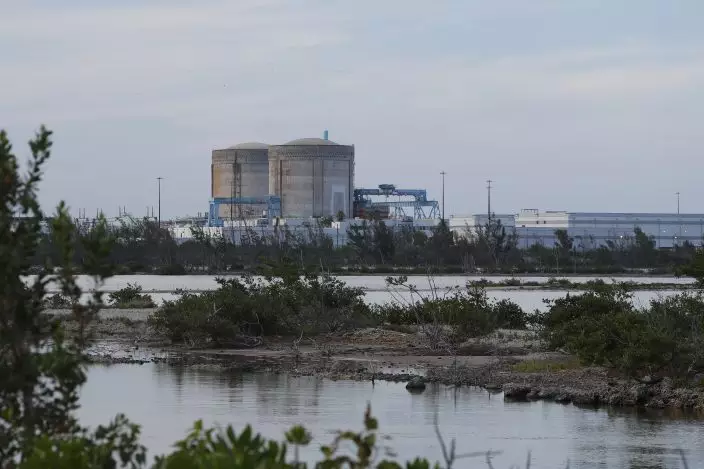
Cooling canals next to the Turkey Point Nuclear Generating Station are shown, Friday, July 19, 2019, in Homestead, Fla. The 168-miles of man-made canals serve as the home to several hundred crocodiles, where a team of specialists working for Florida Power and Light (FPL) monitors and protects the American crocodiles. (AP PhotoWilfredo Lee)
From January to April, Michael Lloret, an FPL wildlife biologist and crocodile specialist, helps create nests and ponds on berms for crocodiles to nest. Once the hatchlings are reared and left by the mother, the team captures them. They are measured and tagged with microchips to observe their development. Lloret then relocates them to increase survival rates.
"We entice crocodiles to come in to the habitats FPL created," Lloret said. "We clear greenery on the berms so that the crocodiles can nest. Because of rising sea levels wasting nests along the coasts, Turkey Point is important for crocodiles to continue."
The canals are one of three major US habitats for crocodiles, where 25% of the 2,000 American crocodiles live. The FPL team has been credited for moving the classification of crocodiles on the Endangered Species Act to "threatened" from "endangered" in 2007. The team has tagged 7,000 babies since it was established in 1978.
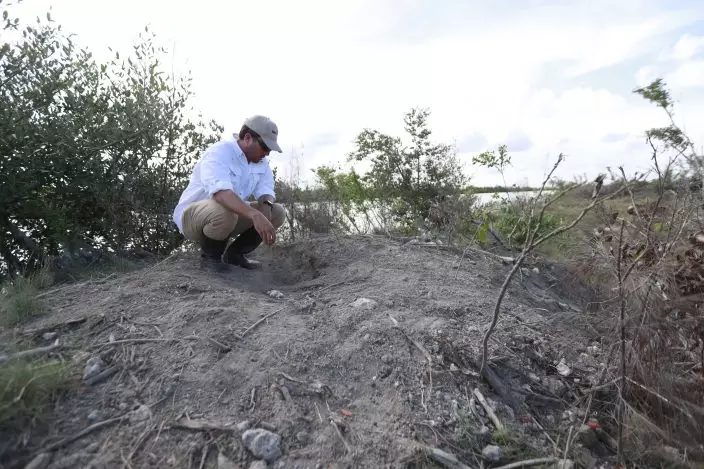
Wildlife biologistcrocodile specialist Michael Lloret points out a crocodile nest on one of the berms along the cooling canals next to the Turkey Point Nuclear Generating Station, Friday, July 19, 2019, in Homestead, Fla. The 168-miles of man-made canals serve as the home to several hundred crocodiles, where a team of specialists working for Florida Power and Light (FPL) monitors and protects the American crocodiles. (AP PhotoWilfredo Lee)
Temperature determines the crocodiles' sex: the hotter it is the more likely males are hatched. Lloret said this year's hatchlings are male-heavy due to last month being the hottest June on record globally.
Because hatchlings released are at the bottom of the food chain, only a small fraction survives to be adults. Lloret said they at least have a fighting chance at Turkey Point, away from humans who hunted them to near-extinction out of greed and fear even though attacks are rare. Only one crocodile attack has ever been recorded in the U.S. - a couple were both bitten while swimming in a South Florida canal in 2014, but both survived.
"American crocodiles have a bad reputation when they are just trying to survive," Lloret said. "They are shy and want nothing to do with us. Humans are too big to be on their menu."

Wildlife biologistcrocodile specialist Michael Lloret demonstrates how he checks the sex of a baby crocodile that came out a crocodile nest on one of the berms along the cooling canals next to the Turkey Point Nuclear Generating Station, Friday, July 19, 2019, in Homestead, Fla. The 168-miles of man-made canals serve as the home to several hundred crocodiles, where a team of specialists working for Florida Power and Light (FPL) monitors and protects the American crocodiles. (AP PhotoWilfredo Lee)
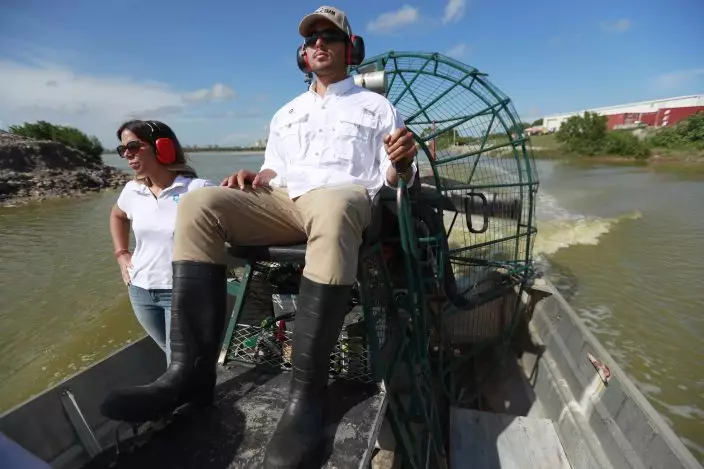
Wildlife biologistcrocodile specialist Michael Lloret, center, pilots an airboat as Bianca Soriano, left, Florida Power and Light (FPL) spokesperson, rides along, through a section of the cooling canals next to the Turkey Point Nuclear Generating Station, Friday, July 19, 2019, in Homestead, Fla. The 168-miles of man-made canals serve as the home to several hundred crocodiles, where a team of specialists working for FPL monitors and protects the American crocodiles. (AP PhotoWilfredo Lee)
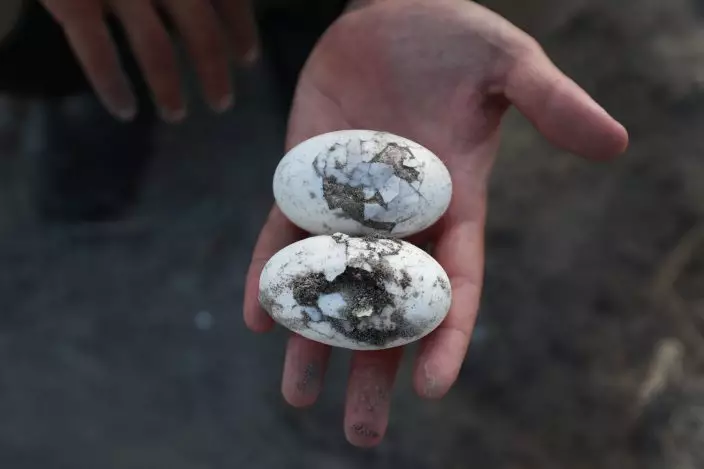
Wildlife biologistcrocodile specialist Michael Lloret holds two infertile eggs that came out a crocodile nest on one of the berms along the cooling canals next to the Turkey Point Nuclear Generating Station, Friday, July 19, 2019, in Homestead, Fla. The 168-miles of man-made canals serve as the home to several hundred crocodiles, where a team of specialists working for Florida Power and Light (FPL) monitors and protects the American crocodiles. (AP PhotoWilfredo Lee)
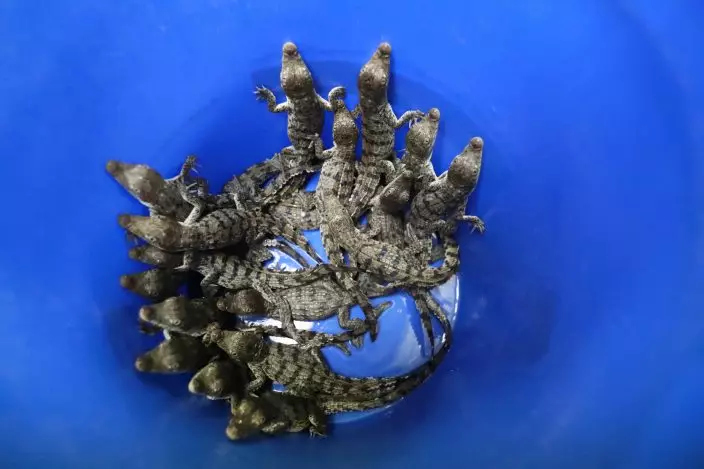
A bucket full of baby crocodiles that were taken out a crocodile nest on one of the berms along the cooling canals next to the Turkey Point Nuclear Generating Station are shown in a lab, Friday, July 19, 2019, in Homestead, Fla. The 168-miles of man-made canals serve as the home to several hundred crocodiles, where a team of specialists working for Florida Power and Light (FPL) monitors and protects the American crocodiles. (AP PhotoWilfredo Lee)
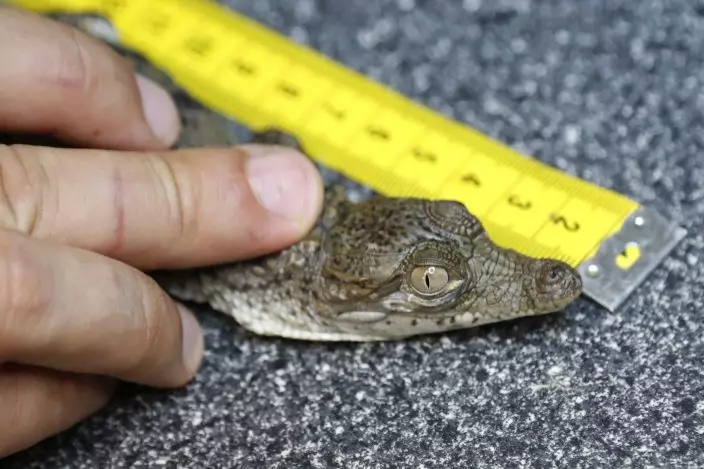
Wildlife biologistcrocodile specialist Michael Lloret demonstrates how he measures a baby crocodile that came out a crocodile nest on one of the berms along the cooling canals next to the Turkey Point Nuclear Generating Station, Friday, July 19, 2019, in Homestead, Fla. The 168-miles of man-made canals serve as the home to several hundred crocodiles, where a team of specialists working for Florida Power and Light (FPL) monitors and protects the American crocodiles. (AP PhotoWilfredo Lee)
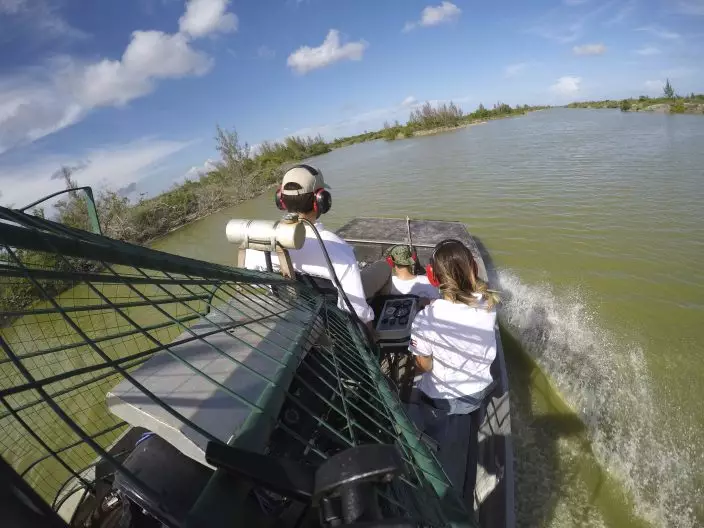
Wildlife biologistcrocodile specialist Michael Lloret, left, pilots an airboat through a section of the cooling canals next to the Turkey Point Nuclear Generating Station, Friday, July 19, 2019, in Homestead, Fla. The 168-miles of man-made canals serve as the home to several hundred crocodiles, where a team of specialists working for Florida Power and Light (FPL) monitors and protects the American crocodiles. (AP PhotoWilfredo Lee)
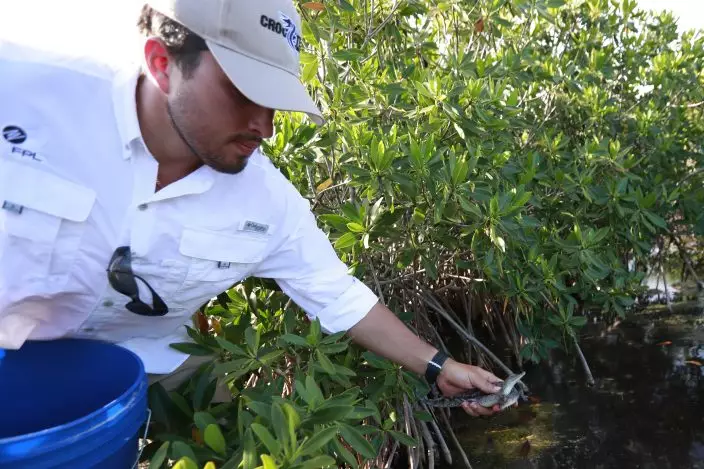
Wildlife biologistcrocodile specialist Michael Lloret releases baby crocodiles back into the wild along the cooling canals next to the Turkey Point Nuclear Generating Station after having measured and tagged them with microchips to observe their development in the future, Friday, July 19, 2019, in Homestead, Fla. The 168-miles of man-made canals serve as the home to several hundred crocodiles, where a team of specialists working for Florida Power and Light (FPL) monitors and protects the American crocodiles. (AP PhotoWilfredo Lee)
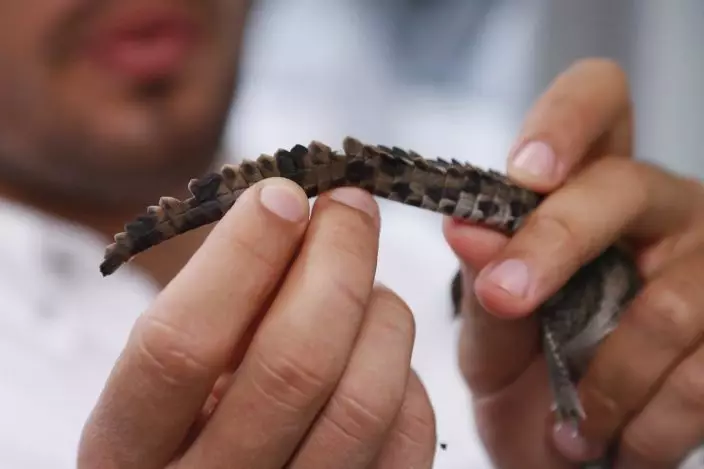
Wildlife biologistcrocodile specialist Michael Lloret shows unique pattern cut out of a baby crocodile's "scutes" for later identification of the crocodile that came out a nest on one of the berms along the cooling canals next to the Turkey Point Nuclear Generating Station, Friday, July 19, 2019, in Homestead, Fla. The 168-miles of man-made canals serve as the home to several hundred crocodiles, where a team of specialists working for Florida Power and Light (FPL) monitors and protects the American crocodiles. (AP PhotoWilfredo Lee)
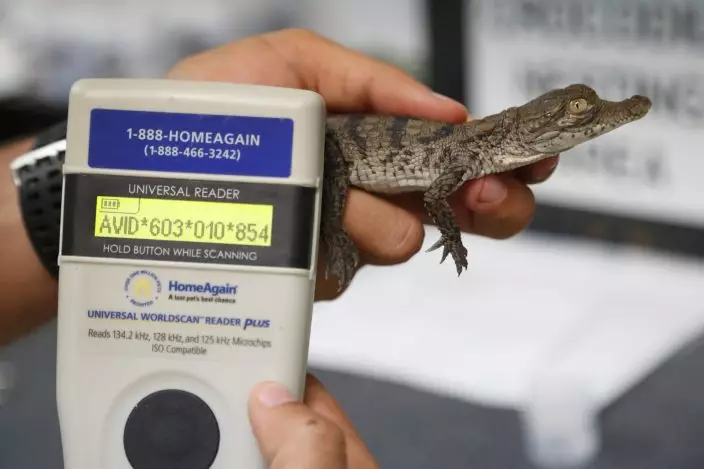
Wildlife biologistcrocodile specialist Michael Lloret demonstrates how he uses a reader to check a microchip that he implanted into a baby crocodile that came out a crocodile nest on one of the berms along the cooling canals next to the Turkey Point Nuclear Generating Station, Friday, July 19, 2019, in Homestead, Fla. The 168-miles of man-made canals serve as the home to several hundred crocodiles, where a team of specialists working for Florida Power and Light (FPL) monitors and protects the American crocodiles. (AP PhotoWilfredo Lee)
TOKYO (AP) — The American envoy to the United Nations called Friday for countries armed with atomic weapons to pursue nuclear disarmament as she visited the atomic bomb museum in Nagasaki, Japan.
Linda Thomas-Greenfield, who became the first U.S. cabinet member to visit Nagasaki, stressed the importance of dialogue and diplomacy amid a growing nuclear threat in the region.
“We must continue to work together to create an environment for nuclear disarmament. We must continue to prevent the spread of nuclear weapons in every corner of the world,” she said after a tour of the atomic bomb museum.
“For those of us who already have those weapons, we must pursue arms control. We can and must work to ensure that Nagasaki is the last place to ever experience the horror of nuclear weapons,” she added, standing in front of colorful hanging origami cranes, a symbol of peace.
The United States dropped the world’s first atomic bomb on Hiroshima on Aug. 6, 1945, destroying the city and killing 140,000 people. A second attack three days later on Nagasaki killed 70,000 more people. Japan surrendered on Aug. 15, ending World War II and its nearly half-century of aggression in Asia.
Nagasaki Gov. Kengo Oishi said in a statement that he believed Thomas-Greenfield's visit and her first-person experience at the museum “will be a strong message in promoting momentum of nuclear disarmament for the international society at a time the world faces a severe environment surrounding atomic weapons.”
Oishi said he conveyed to the ambassador the increasingly important role of Nagasaki and Hiroshima in emphasizing the need of nuclear disarmament.
Thomas-Greenfield's visit to Japan comes on the heels of Prime Minister Fumio Kishida's official visit to the United States last week and is aimed at deepening Washington's trilateral ties with Tokyo and Seoul. During her visit to South Korea earlier this week, she held talks with South Korean officials, met with defectors from North Korea and visited the demilitarized zone.
The ambassador said the United States is looking into setting up a new mechanism for monitoring North Korea's nuclear weapons program. Russia and China have thwarted U.S.-led efforts to step up U.N. sanctions on North Korea over its ballistic missile testing since 2022, underscoring a deepening divide between permanent Security Council members over Russia’s war on Ukraine.
She said it would be “optimal” to launch the new system next month, though it is uncertain if that is possible.
The U.N. Security Council established a committee to monitor sanctions, and the mandate for its panel of experts to investigate violations had been renewed for 14 years until last month, when Russia vetoed another renewal.
In its most recent report, the panel of experts said it is investigating 58 suspected North Korean cyberattacks between 2017 and 2023 valued at approximately $3 billion, with the money reportedly being used to help fund its weapons development.
The United States, Japan and South Korea have been deepening security ties amid growing tension in the region from North Korea and China.
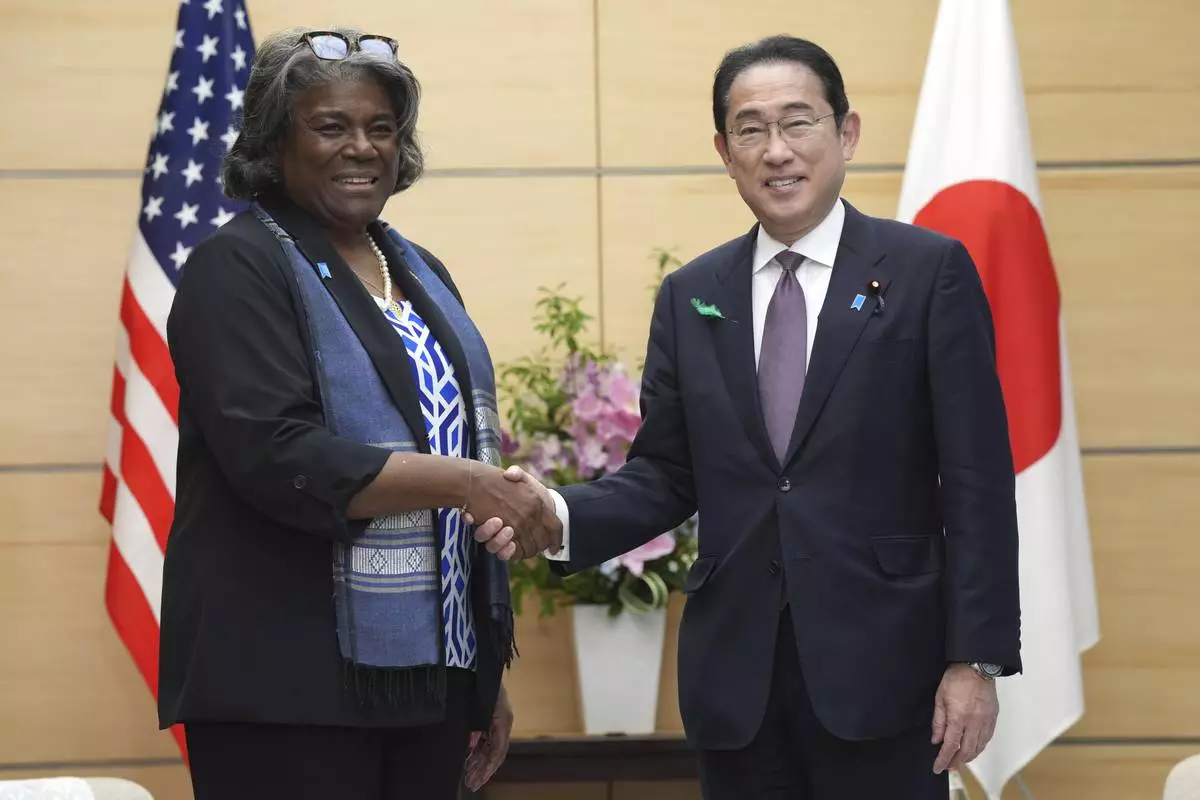
U.S. Ambassador to United Nations Linda Thomas-Greenfield, left, and Japan's Prime Minister Fumio Kishida, right, shake hands during a meeting Friday, April 19, 2024, at prime minister's office in Tokyo. (AP Photo/Eugene Hoshiko, Pool)

U.S. Ambassador to United Nations Linda Thomas-Greenfield, left, and Japan's Prime Minister Fumio Kishida, right, shake hands during a meeting Friday, April 19, 2024, at prime minister's office in Tokyo. (AP Photo/Eugene Hoshiko, Pool)
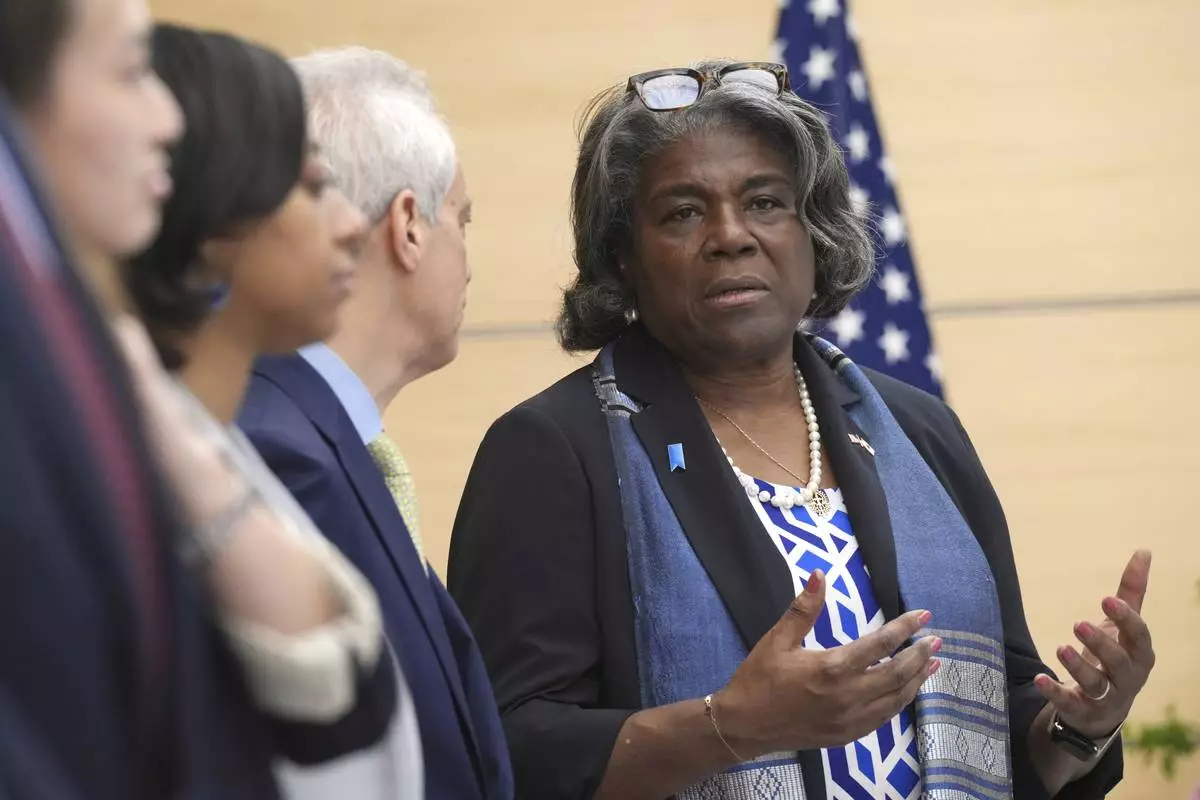
U.S. Ambassador to United Nations Linda Thomas-Greenfield, right, speaks to Rahm Emanuel, U.S. Ambassador to Japan, second right, as they wait for a meeting with Japan's Prime Minister Fumio Kishida Friday, April 19, 2024, at prime minister's office in Tokyo. (AP Photo/Eugene Hoshiko, Pool)
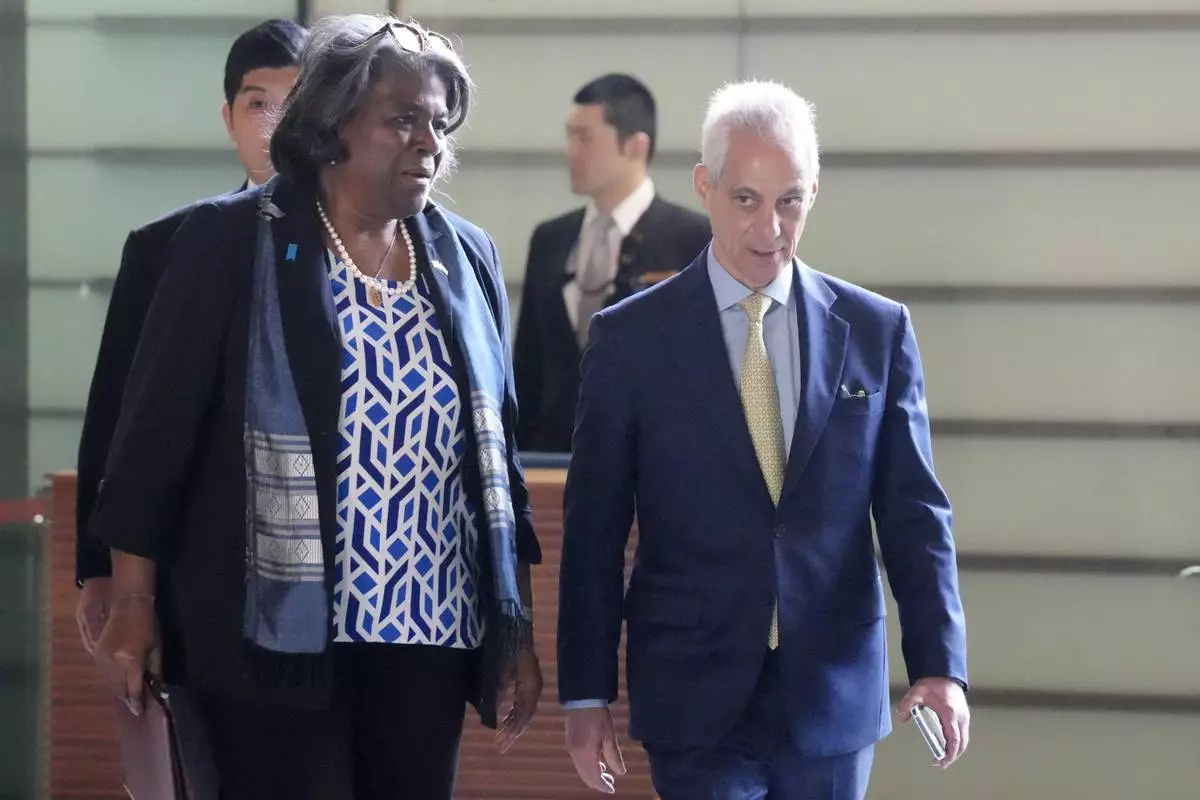
U.S. Ambassador to United Nations Linda Thomas-Greenfield, left, and Rahm Emanuel, U.S. Ambassador to Japan, right, walk to meet Japan's Prime Minister Fumio Kishida Friday, April 19, 2024, at prime minister's office in Tokyo. (AP Photo/Eugene Hoshiko, Pool)
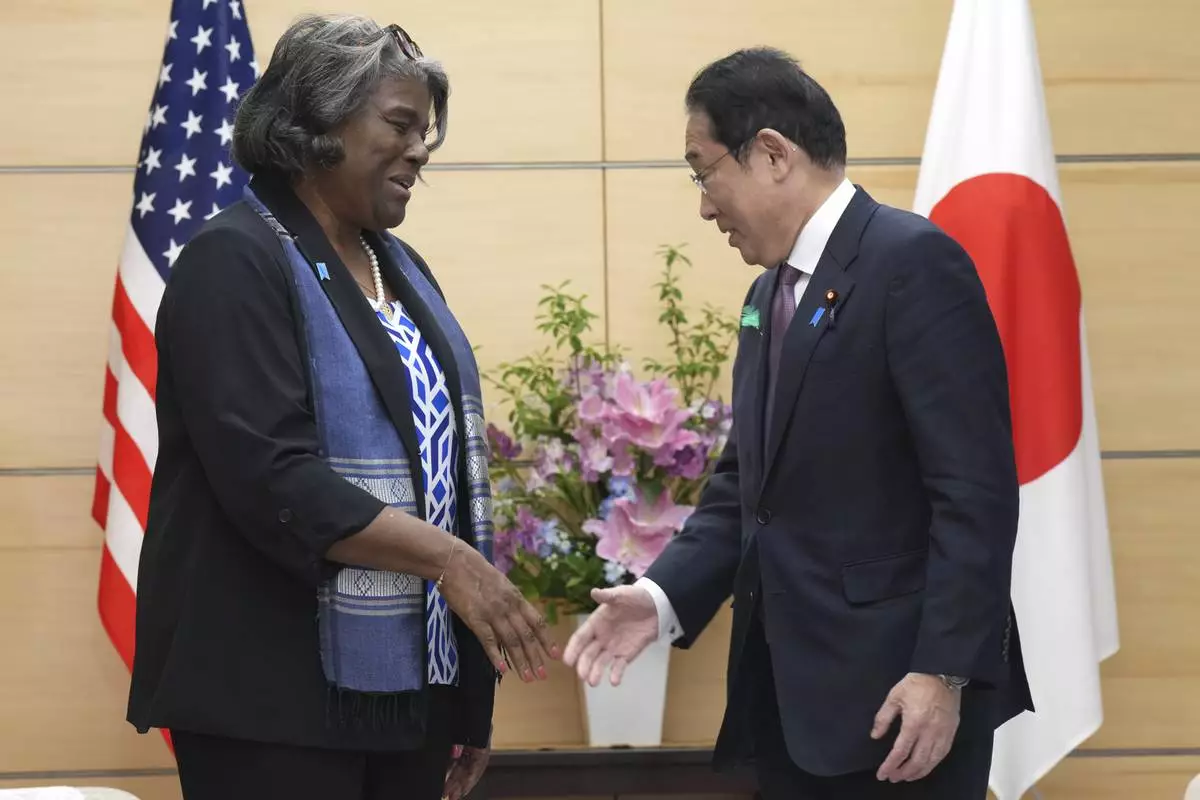
U.S. Ambassador to United Nations Linda Thomas-Greenfield, left, and Japan's Prime Minister Fumio Kishida, right, talk prior to a meeting Friday, April 19, 2024, at prime minister's office in Tokyo. (AP Photo/Eugene Hoshiko, Pool)
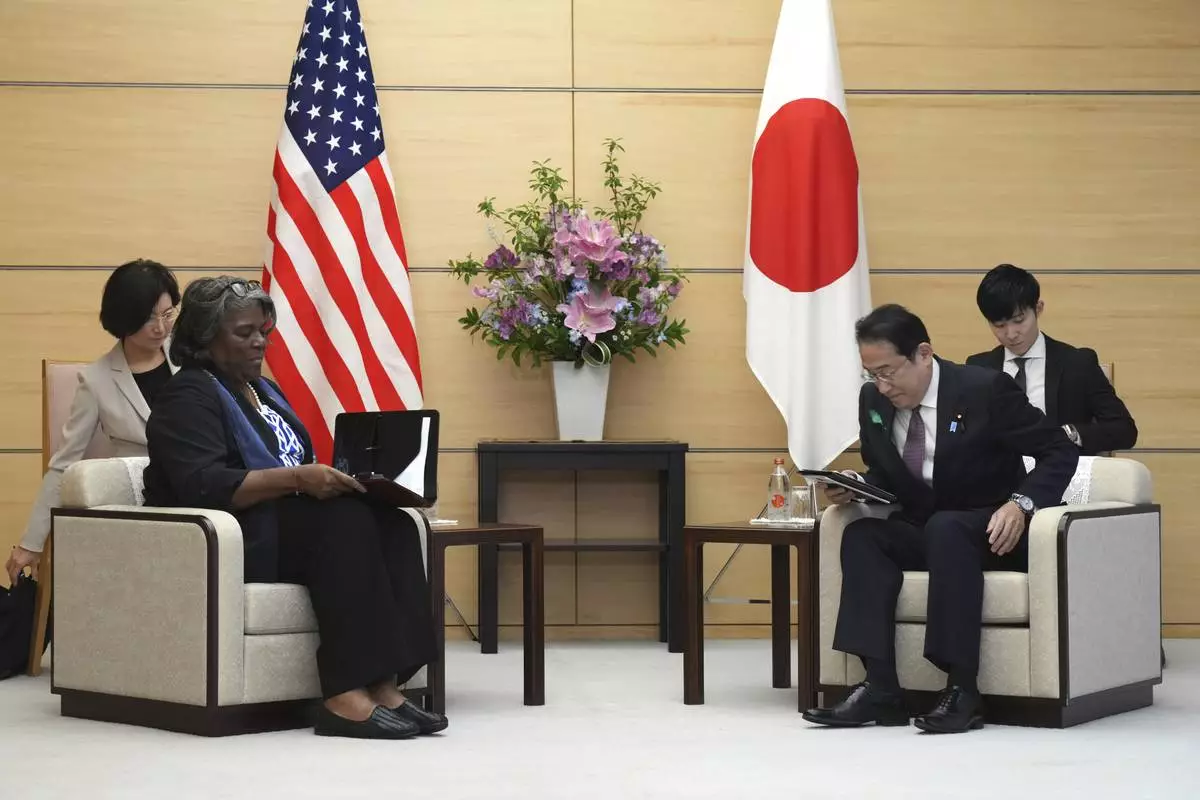
U.S. Ambassador to United Nations Linda Thomas-Greenfield, left, and Japan's Prime Minister Fumio Kishida, right, prepare to talk during a meeting Friday, April 19, 2024, at prime minister's office in Tokyo. (AP Photo/Eugene Hoshiko, Pool)





















